The schnauzer is a distinctive and beloved breed of dog that has been a cherished companion for generations of pet owners. With their signature shaggy eyebrows, bushy beard, and pointy ears, schnauzers are a unique and charismatic breed that has captured the hearts of dog lovers around the world.
Originally bred in Germany during the 19th century, schnauzers were initially developed as working dogs, used for tasks such as guarding livestock and hunting vermin. Today, they are primarily kept as pets and are known for their affectionate nature, loyalty, and intelligence.
One of the most notable characteristics of the schnauzer is their distinct coat, which comes in three varieties: standard, miniature, and giant. The standard schnauzer is the original and largest of the three, standing around 17-20 inches tall at the shoulder and weighing between 35-50 pounds.
The miniature schnauzer is a smaller version, standing around 12-14 inches tall and weighing between 11-20 pounds. The giant schnauzer is the largest of the three, standing around 23-28 inches tall and weighing between 65-90 pounds.
Regardless of their size, all schnauzers have a dense, wiry coat that requires regular grooming to maintain. They also have distinctive eyebrows and beards that require extra attention to keep clean and free from mats and tangles.
Schnauzers are known for their intelligence and trainability. They are quick learners and excel in obedience training and other dog sports such as agility and tracking. They are also known for their loyalty and make excellent companions for families, individuals, and seniors alike.
While schnauzers are generally healthy and long-lived dogs, they can be prone to certain health issues such as hip dysplasia, eye problems, and skin allergies. Regular veterinary care, a balanced diet, and exercise can help minimize the risk of these and other health concerns.
Overall, schnauzers are a delightful and unique breed that make wonderful companions for those looking for a loyal and intelligent dog. With their distinctive appearance and charming personality, it’s no wonder that schnauzers have captured the hearts of dog lovers around the world.
Read Also: Importance of Turmeric and Turmeric Interaction
Appearance Of The Schnauzer Dog Breed
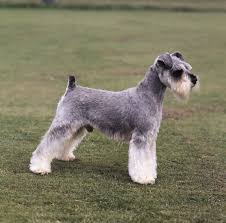
Schnauzers are a medium-sized breed of dog with a distinctive appearance. They have a square-shaped head with a strong jaw and dark, oval-shaped eyes that exude intelligence and alertness. One of the most notable physical features of the schnauzer is their shaggy eyebrows and prominent beard, which give them a distinctive look that is often likened to that of a gentleman.
The schnauzer’s coat is dense and wiry, and it comes in three different varieties: standard, miniature, and giant. The standard schnauzer’s coat is typically salt-and-pepper in color, while the miniature and giant varieties can come in a wider range of colors including black, black and silver, and pure white. Regardless of the color, all schnauzer coats require regular grooming to prevent matting and to maintain their signature appearance.
The schnauzer’s distinctive appearance and charming personality have made them a beloved breed of dog for many people around the world.
History and Origin Of Schnauzer Dogs
The exact origin of the schnauzer is somewhat unclear, but it is believed that they were created by crossing several different breeds of dog, including the poodle, the Affenpinscher, and the gray spitz. The resulting breed was sturdy, intelligent, and versatile, and quickly became popular with farmers, tradespeople, and other working-class people.
The schnauzer’s popularity continued to grow throughout the 20th century, and the breed was eventually recognized by the American Kennel Club in 1904. Today, schnauzers are a popular breed of dog around the world and are known for their loyal and affectionate nature, as well as their intelligence and trainability.
In addition to their role as working dogs, schnauzers have also been used in various other capacities throughout history. During World War I and World War II, schnauzers were used as messenger dogs and for other military purposes. They have also been used as police dogs, search and rescue dogs, and therapy dogs.
While the schnauzer’s exact origin may be somewhat shrouded in mystery, there is no denying the impact that this breed has had on the dog world. From their humble beginnings as a working-class dog in Germany, to their status as a beloved family pet around the world, the schnauzer is a breed that has stood the test of time and continues to capture the hearts of dog lovers everywhere.
Health Issues and Lifespan Of The Schnauzer Dog Breed
One of the most common health issues in schnauzers is hip dysplasia, which is a condition where the hip joint does not develop properly and can result in pain, discomfort, and difficulty walking. Other potential health concerns include eye problems such as cataracts and glaucoma, skin allergies, and bladder stones.
To ensure that your schnauzer remains healthy and happy, it is important to provide them with regular veterinary care, a balanced diet, and plenty of exercise. Regular grooming is also essential to prevent skin irritations and to maintain their distinctive coat.
With proper care, schnauzers can live long and healthy lives. The average lifespan of a schnauzer is typically around 12-14 years, although some dogs may live longer with proper care and attention.
It is important to note that certain health issues may be more common in specific varieties of schnauzers. For example, giant schnauzers may be more prone to certain types of cancer, while miniature schnauzers may be more prone to dental issues.
If you are considering getting a schnauzer, it is important to research the specific health concerns that may be associated with the variety you are interested in and to discuss these concerns with a reputable breeder or veterinarian.
The Schnauzer Dogs Complete Grooming and Care Guide
Coat Care: Schnauzers have a thick, wiry coat that requires regular grooming to prevent matting and tangling. Brushing your schnauzer’s coat regularly with a slicker brush will help to remove loose hair and prevent tangles. You may also want to use a comb to detangle any knots that you find. Schnauzers also benefit from regular trimming to keep their coat looking neat and tidy.
Bathing: While schnauzers don’t require frequent bathing, you should give your dog a bath every few months to keep its coat clean and healthy. When giving your schnauzer a bath, use a gentle, dog-specific shampoo and conditioner. Make sure to rinse your dog thoroughly to avoid leaving any shampoo residue on its skin.
Dental Care: Like all dogs, schnauzers are susceptible to dental problems such as gum disease and tooth decay. To prevent these issues, it’s important to provide your schnauzer with proper dental care. This includes brushing its teeth regularly with a dog-specific toothpaste, providing dental chews or treats, and scheduling regular professional cleanings with your veterinarian.
Ear Care: Schnauzers have long, floppy ears that can trap dirt and debris, leading to ear infections. To prevent these issues, it’s important to clean your schnauzer’s ears regularly with a dog-specific ear cleaner. Make sure to follow the instructions on the bottle and avoid inserting anything into your dog’s ear canal.
Nail Care: Keeping your schnauzer’s nails trimmed is important for its comfort and health. Long nails can cause discomfort and even lead to joint problems over time. You should trim your schnauzer’s nails every few weeks or as needed, being careful not to cut into the quick (the pink part of the nail that contains blood vessels).
Exercise: Schnauzers are an active breed that requires regular exercise to maintain their physical and mental health. Daily walks, playtime in the backyard, and interactive games can all help to keep your schnauzer happy and healthy.
Nutrition: Providing your schnauzer with a healthy, balanced diet is crucial for its overall health and wellbeing. Make sure to choose a high-quality dog food that is appropriate for your dog’s age, size, and activity level. You may also want to talk to your veterinarian about supplements that can support your schnauzer’s health.
However, grooming and caring for your schnauzer is essential for its health and happiness. Regular coat care, bathing, dental care, ear care, nail care, exercise, and nutrition can all help to keep your schnauzer healthy and happy for years to come. As always, consult with your veterinarian for personalized advice and recommendations for your specific schnauzer.
Miniature Schnauzer
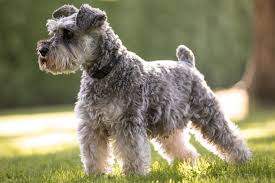
Miniature schnauzers are small, sturdy dogs that typically weigh between 11 to 20 pounds and stand 12 to 14 inches tall at the shoulder. They have a distinctive, wiry coat that can be black, salt and pepper, or black and silver in color. Their eyebrows, mustache, and beard give them a distinctive, almost human-like expression.
Miniature schnauzers are known for their lively and affectionate personalities. They are intelligent, loyal, and playful dogs that make great companions for families and individuals alike. They have a strong prey drive and may be inclined to chase small animals, so it’s important to keep them on a leash or in a securely fenced yard. With proper socialization and training, they can get along well with other dogs and children.
Like standard schnauzers, miniature schnauzers have a thick, wiry coat that requires regular grooming. Brushing their coat a few times a week can help prevent matting and tangling. They should also be trimmed every few months to keep their coat looking neat and tidy. It’s also important to clean their ears regularly to prevent infections.
Miniature schnauzers are active dogs that require daily exercise and mental stimulation to stay healthy and happy. Daily walks, playtime in the backyard, and interactive games can all help keep them active and engaged. They are intelligent and eager to please, making them relatively easy to train. Positive reinforcement training methods are recommended.
Like all dogs, miniature schnauzers can be prone to certain health issues, such as hip dysplasia, eye problems, and diabetes. It’s important to schedule regular check-ups with a veterinarian to monitor their health and catch any potential issues early on.
The miniature schnauzer is a delightful and affectionate breed that makes a great companion for individuals and families alike. They are intelligent, playful, and require regular grooming and exercise to stay healthy and happy. With proper care and attention, miniature schnauzers can live long, healthy lives.
Standard Schnauzer
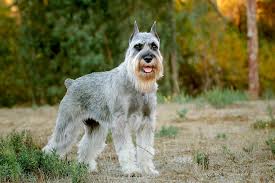
The Standard Schnauzer is a medium-sized dog
Standard Schnauzers are strong, muscular dogs that typically stand 17 to 20 inches tall at the shoulder and weigh between 35 and 50 pounds. They have a distinctive, wiry coat that comes in solid black or salt and pepper (a mix of black and white hairs). Their eyebrows and beard give them a distinct and intelligent expression.
Standard Schnauzers are known for their loyal and protective nature. They are confident and intelligent dogs that make excellent watchdogs and family pets. They are also playful and enjoy spending time with their families. However, they can be wary of strangers and other dogs, so early socialization is important. They respond well to positive reinforcement training methods and enjoy learning new tricks and commands.
Standard Schnauzers have a thick, wiry coat that requires regular grooming to prevent matting and tangling. Brushing their coat a few times a week can help keep it in good condition. They also require trimming every few months to keep their coat looking neat and tidy. It’s also important to regularly clean their ears to prevent infections.
Standard Schnauzers are active dogs that require daily exercise and mental stimulation to stay healthy and happy. Daily walks, playtime in the backyard, and interactive games can all help keep them active and engaged. They are intelligent and eager to please, making them relatively easy to train. Positive reinforcement training methods are recommended.
Like all dogs, Standard Schnauzers can be prone to certain health issues, such as hip dysplasia and eye problems. It’s important to schedule regular check-ups with a veterinarian to monitor their health and catch any potential issues early on.
However, the Standard Schnauzer is a versatile and intelligent breed that makes a great companion for families and individuals who are willing to give them the exercise and mental stimulation they need. They require regular grooming and training, but their loyalty and affectionate nature make them well worth the effort.
Read Also: Strawberries and it’s Nutritional Benefits
Schnauzer Puppy
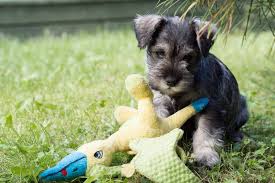
Schnauzer puppies require a high-quality puppy food that is specifically formulated for their nutritional needs. It’s important to feed them small, frequent meals throughout the day to help them grow and maintain their energy levels. As they get older, you can gradually reduce the number of meals to 2-3 per day.
Early socialization and training is crucial for schnauzer puppies. They are intelligent and eager to please, but they can also be stubborn at times. Positive reinforcement training methods, such as using treats and praise, are recommended. Consistency and patience are key when it comes to training your schnauzer puppy.
Schnauzer puppies are active and require regular exercise to keep them healthy and happy. Daily walks, playtime in the backyard, and interactive games can all help keep them active and engaged. However, it’s important not to over-exercise them as their bones and joints are still developing.
Schnauzer puppies have a thick, wiry coat that requires regular grooming to prevent matting and tangling. Brushing their coat a few times a week can help keep it in good condition. It’s also important to trim their coat every few months to keep it looking neat and tidy. Additionally, it’s important to clean their ears regularly to prevent infections.
Regular visits to the veterinarian are important to ensure your schnauzer puppy stays healthy. They will require vaccinations and routine check-ups to monitor their growth and development. It’s also important to keep up with flea and tick prevention, as well as heartworm prevention.
However, taking care of a schnauzer puppy requires time, patience, and dedication. With proper feeding, training, exercise, grooming, and healthcare, you can ensure that your schnauzer puppy grows up to be a healthy and happy adult dog.
Where to Find Miniature Schnauzer for Sale near Me/You
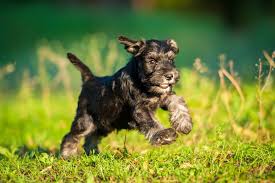
When looking to find or locate miniature schnauzers for sale, it’s important to do your research to ensure you are getting a healthy and well-bred puppy. Here are a few options to consider:
Reputable breeders: Look for breeders who are members of breed clubs or organizations and who have a good reputation for breeding healthy and well-tempered schnauzers. You can search for breeders online or through breed club directories.
Rescue organizations: Consider adopting a miniature schnauzer from a rescue organization. These organizations rescue and rehabilitate schnauzers who have been abandoned, surrendered, or mistreated. You can search for rescue organizations online or through breed club directories.
Pet stores: Some pet stores may carry miniature schnauzers for sale, but be cautious and do your research. Make sure the store has a good reputation and that the puppies are from reputable breeders.
Online marketplaces: There are many online marketplaces where breeders and individuals can advertise puppies for sale. However, be cautious when buying a puppy online and make sure to ask for health records and proof of vaccinations.
When considering where to find or locate a miniature schnauzer for sale, it’s important to prioritize the health and well-being of the puppy. Always do your research, ask for references and health records, and make sure you feel comfortable with the breeder or seller before making a purchase.
Read Also: Vinegar Drink Recipes You Should Try





